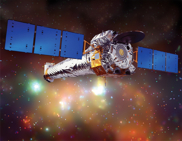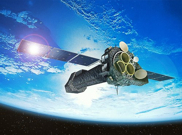
 Chandra X-ray Observatory
Chandra X-ray ObservatoryThe Chandra X-ray Observatory, a NASA Great Observatory, provides the most detailed view to date of the X-ray universe. With its exquisite imaging capabilities and high spectral resolution scientists have investigated phenomena as diverse as the spectra of Jupiter's aurora, the effects of dark energy on the growth of galaxy clusters, and the properties of faint x-ray sources in deep fields.
 Fermi
FermiThe Fermi Gamma-Ray Space Telescope (formerly GLAST) is providing our deepest and most detailed map of the gamma-ray sky. Fermi has recorded high-energy gamma rays produced by supernovae, pulsars, extreme flows of energy from systems powered by black holes, and gamma-ray bursts.
 XMM-Newton
XMM-NewtonXMM-Newton, the X-ray Multi-Mirror Mission, is the second cornerstone of the ESA Horizon 2000 program. With high collecting area in the x-ray band, XMM provides vital information for studies of fundamental and relativistic processes from neutron stars and active galactic nuclei, the creation and dispersal of the elements in supernovae, the distribution of dark matter in clusters, groups, and elliptical galaxies, and young active stars to constrain models of the early solar system and star forming regions.
The following missions are part of the Explorer Program, but their science is closely related to the Physics of the Cosmos Theme.
 ISS-CREAM
ISS-CREAMThe Cosmic-Ray Energetics and Mass for the International Space Station investigation, known as ISS-CREAM, places a highly successful balloon-borne instrument aboard the International Space Station where it gathers an order of magnitude (10 times) more data, which has lower background interference because Earth's atmosphere is no longer interfering. ISS-CREAM's instruments measure the charges of cosmic rays ranging from hydrogen up through iron nuclei, over a broad energy range. The modified balloon instrument is carried aloft on a Space X Dragon Lab cargo supply mission and placed on the Japanese Exposed Module for a period of at least three years.
 NICER
NICERThe Neutron star Interior Composition Explorer (NICER) is an International Space Station (ISS) payload devoted to the study of neutron stars through soft X-ray timing. Neutron stars are unique environments in which all four fundamental forces of nature are simultaneously important. The nature of matter under these conditions is a decades-old unsolved problem, one most directly addressed with measurements of the masses and, especially, radii of neutron stars to high precision (i.e., better than 10 percent uncertainty). NICER will enable rotation-resolved spectroscopy of the thermal and non-thermal emissions of neutron stars in the soft (0.2-12 keV) X-ray band with unprecedented sensitivity, probing interior structure, the origins of dynamic phenomena, and the mechanisms that underlie the most powerful cosmic particle accelerators known.

Program News and Announcements
Project News
Related News